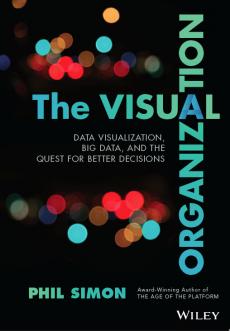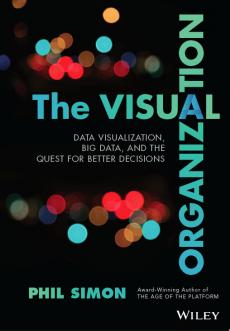The following is a guest post from Phil Simon (@philsimon), with an excerpt from his new book, The Visual Organization: Data Visualization, Big Data, and the Quest for Better Decisions. Phil is a frequent keynote speaker and recognized technology expert. He is the award-winning author of six management books and consults organizations on matters related to strategy, data, and technology.
---
Fifteen years ago, the presentation of data wasn’t terribly  democratic, sophisticated, and interactive, especially compared to today. Tech-savvy analysts and IT professionals generated static diagrams, graphs, and charts for quarterly or annual meetings or “special events.” Back then, cutting-edge dataviz wasn’t part and parcel to many jobs. There just wasn’t that much data, especially compared to today.
democratic, sophisticated, and interactive, especially compared to today. Tech-savvy analysts and IT professionals generated static diagrams, graphs, and charts for quarterly or annual meetings or “special events.” Back then, cutting-edge dataviz wasn’t part and parcel to many jobs. There just wasn’t that much data, especially compared to today.
In a way, this was entirely understandable. Yes, the late-1990s saw the advent of modern enterprise reporting and BI applications adroit at representing mostly structured data. In most organizations, however, relatively few people regularly visualized data, at least not on a regular basis.
My, how times have changed. Now data is everywhere. As I wrote in Too Big to Ignore, we are living in the era of Big Data, and many things are changing. In the workplace, let’s focus on two major shifts. First, today it is becoming incumbent upon just about every member of a team, group, department, and organization to be, at a minimum, comfortable with data. Fewer and fewer knowledge workers can hide from quantitative analysis. Second, pie charts, bar charts, and other simple data visualizations of 15 years ago now seem quaint. They don’t remotely resemble anything that qualifies as contemporary dataviz. More important, today they often fail to tell the stories that need to be told.
Next, data no longer needs be presented on an occasional or periodic basis. We are constantly looking at data of all types—a trend that will only intensify in the coming years. Before our eyes, we are seeing the ability to effectively present quantitative information in a compelling manner become a professional sine qua non. Hidden in the petabytes of structured and unstructured data are key consumer, employee, and organizational insight. If found and unleashed, those insights would invariably move the needle.
The PwC survey confirmed what I have long assumed. Although notable exceptions exist, only a minority of organizations and professionals currently do very much with dataviz. Most enterprises fail to present data in visually compelling ways. Far too many rely upon old standbys: bar charts, simple graphs, and the ubiquitous Excel spreadsheet. And their business decisions suffer as a result.
Why the widespread lack of adoption? I’d posit that several factors are at play here. First, while dataviz is hardly new, the landscape is. Many of the applications and services detailed in Chapter 2 are recent advents. Second, I have little doubt that the explosions of dataviz and Big Data left many CXOs overwhelmed. In this way, dataviz is much like cloud computing. With myriad options, it’s natural for those in control of the purse strings to ask, “Where do we even start?”
Next, many organizations suffer from downright ignorance. Many lack the knowledge that better tools exist, not to mention that enterprises are successfully using them. (Hopefully, this book will change that, at least to some extent.) Then there are organizations whose cultures systematically ignore data and analysis. I have seen my share of those As such, their employees generally lack the willingness to try, buy, deploy, and use contemporary dataviz tools. When corporate fiat, culture, and politics dominate decision-making, what’s the point of even looking at data?
For these reasons, it should be no surprise that Big Data is still in its infancy. Brian McKenna tackles this subject in an April 2013 ComputerWeekly article. About the state of Big Data, he writes that “Analytics firm SAS and SourceMedia surveyed 339 data-management professionals about their organizations’ use of data-management technology in December 2012, discovering reality still lags behind hype. Only 12 percent of information management professionals are doing Big Data, according to a recent survey.”7 Remarkably, only 14 percent of respondents categorized their organizations as “very likely” to begin working with Big Data in 2014. Nearly one in five responded “not likely at all.”
The hype around Big Data and, to a lesser extent, dataviz still far exceeds their business realities. To quote former Notre Dame coach Lou Holtz, “When all is said and done, more is said than done.” Rather than hem and haw, organizations should recognize the vast opportunity that the status quo represents. Those that act now can realize significant benefits that won’t be available to them once their competition wakes up.

%20Logo_BlueOrange_Trademark.png?width=800&height=269&name=Ready%20North%20(RN)%20Logo_BlueOrange_Trademark.png)




.jpg?width=300&name=Services%20Hub%203%20(3).jpg)


COMMENTS